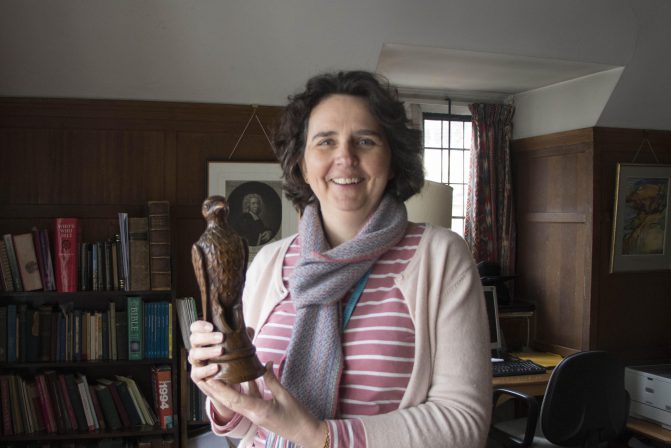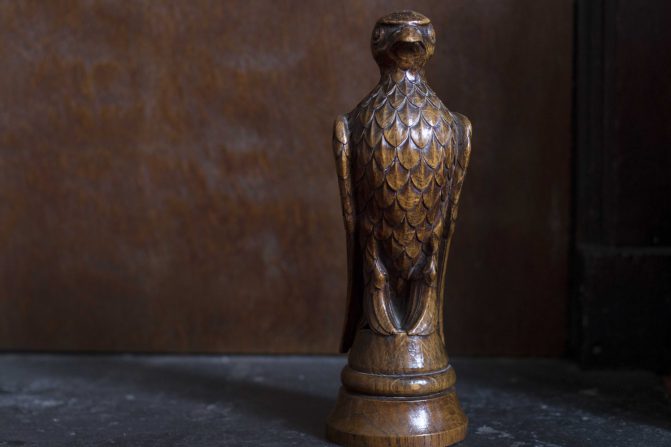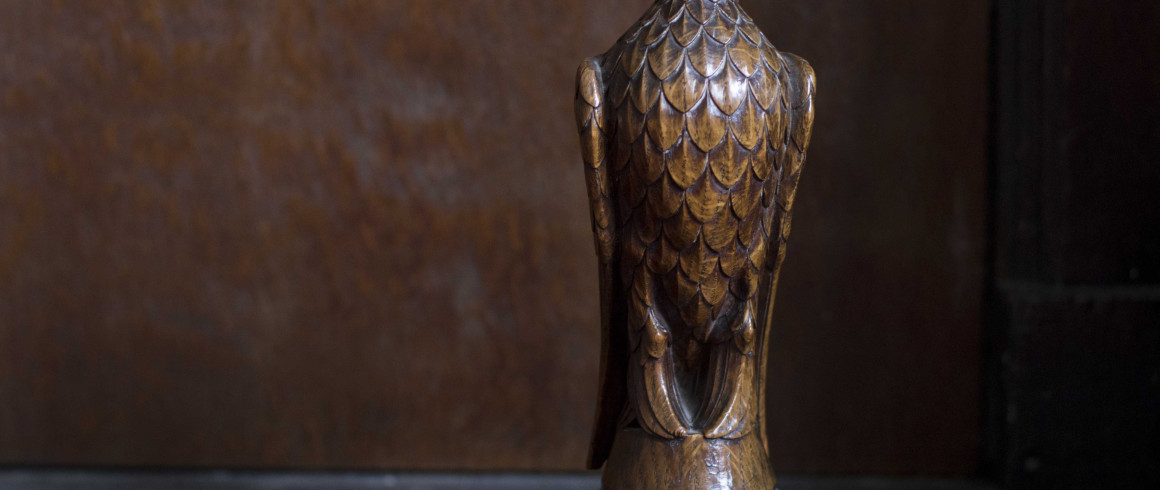The Pembroke Collections Cataloguer
Lucy McNeill has been with Pembroke for nine months, cataloguing the College's collections and seeking out hidden treasures. In this blog she writes about her work. During the nine months (August 2017-May 2018) that I have had the privilege to be the Pembroke Collections Cataloguer I have amalgamated all existing collections into a single Collections Management System to professional museum standards. Over 1500 object records have been brought together in a unified catalogue which covers, fine art, decorative art, silver, minerals and sporting related items. To achieve a unified catalogue my first task was to bring together the existing lists of objects. These existed in various formats; word, excel and access. From there I needed to verify what the lists recorded and then to launch into a detailed programme of creating new records for objects previously unrecorded. Initially I visited staff offices and the more open places in the College, for example the Library, to catalogue the treasures and later visited Fellows Rooms and unique locations, for instance, the Chapel Office. I have transformed the Picture Store in Foundress Court into a functional resource; every item has been catalogued, numbered photographed and labelled. A desk has been purchased and fits in the Store perfectly. It soon became apparent that the College had many treasures in all manner of materials. To ensure the College treasures were recorded to professional museum standards I consulted with the Collections Trust and sought an mda code for the collection. An mda code identifies the collection-holding organisation and their collection. The Pembroke code is CAMPC. The first three letters designate Cambridge and the last two identify Pembroke College. The code forms part of the object record number. The treasures have been classified as Paintings (PTG), Works on Paper (WOP), Decorative Art (DAR), Silver (SMW), Minerals (MIN) and Sporting Related Items (SRI). I introduced a systematic numbering sequence within each classification. To form a complete object record number the mda code is followed by the classification and then a number, for example, CAMPC_MIN_00010 is the mineral, lapis lazuli, housed in the Christopher Smart Room. Pembroke College commissioned the database, MuseumPlusRIA, from zetcom in 2017. I worked with the project curator, Simon Learmount, and the IT Director, Andy Baugham on the configuration and functionality of the database. The database was customised to fulfil the unique requirements of the College; for example, a ‘statement of significance’ field was added to the object domain so an explanation of the significance of the object to the history of the College can be noted. A ‘function’ field was added to the object domain to provide information on the accessibility and use of objects: the four categories in the term list are (1) general use, (2) restricted use (3) special occasion and (4) display only. A universal term list for locations within the College has been created. It will now be easy to identify the location of an object. This locations list will now be used across the College by all departments as there had not been a standardised list before. By customising the database in this way the professional management of the College treasures is secured for the future. One of my favourite objects, which I came across during this project, is the wooden martlet which resides in Brian Watchorn’s office. The quality of the carving and the superb condition are the essence of a College treasure.
During the nine months (August 2017-May 2018) that I have had the privilege to be the Pembroke Collections Cataloguer I have amalgamated all existing collections into a single Collections Management System to professional museum standards. Over 1500 object records have been brought together in a unified catalogue which covers, fine art, decorative art, silver, minerals and sporting related items. To achieve a unified catalogue my first task was to bring together the existing lists of objects. These existed in various formats; word, excel and access. From there I needed to verify what the lists recorded and then to launch into a detailed programme of creating new records for objects previously unrecorded. Initially I visited staff offices and the more open places in the College, for example the Library, to catalogue the treasures and later visited Fellows Rooms and unique locations, for instance, the Chapel Office. I have transformed the Picture Store in Foundress Court into a functional resource; every item has been catalogued, numbered photographed and labelled. A desk has been purchased and fits in the Store perfectly. It soon became apparent that the College had many treasures in all manner of materials. To ensure the College treasures were recorded to professional museum standards I consulted with the Collections Trust and sought an mda code for the collection. An mda code identifies the collection-holding organisation and their collection. The Pembroke code is CAMPC. The first three letters designate Cambridge and the last two identify Pembroke College. The code forms part of the object record number. The treasures have been classified as Paintings (PTG), Works on Paper (WOP), Decorative Art (DAR), Silver (SMW), Minerals (MIN) and Sporting Related Items (SRI). I introduced a systematic numbering sequence within each classification. To form a complete object record number the mda code is followed by the classification and then a number, for example, CAMPC_MIN_00010 is the mineral, lapis lazuli, housed in the Christopher Smart Room. Pembroke College commissioned the database, MuseumPlusRIA, from zetcom in 2017. I worked with the project curator, Simon Learmount, and the IT Director, Andy Baugham on the configuration and functionality of the database. The database was customised to fulfil the unique requirements of the College; for example, a ‘statement of significance’ field was added to the object domain so an explanation of the significance of the object to the history of the College can be noted. A ‘function’ field was added to the object domain to provide information on the accessibility and use of objects: the four categories in the term list are (1) general use, (2) restricted use (3) special occasion and (4) display only. A universal term list for locations within the College has been created. It will now be easy to identify the location of an object. This locations list will now be used across the College by all departments as there had not been a standardised list before. By customising the database in this way the professional management of the College treasures is secured for the future. One of my favourite objects, which I came across during this project, is the wooden martlet which resides in Brian Watchorn’s office. The quality of the carving and the superb condition are the essence of a College treasure.
